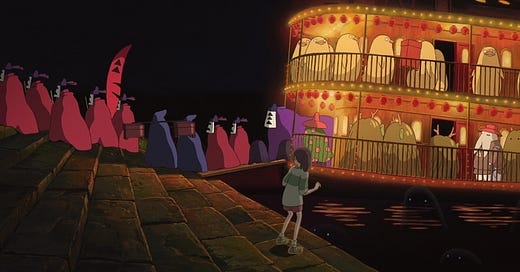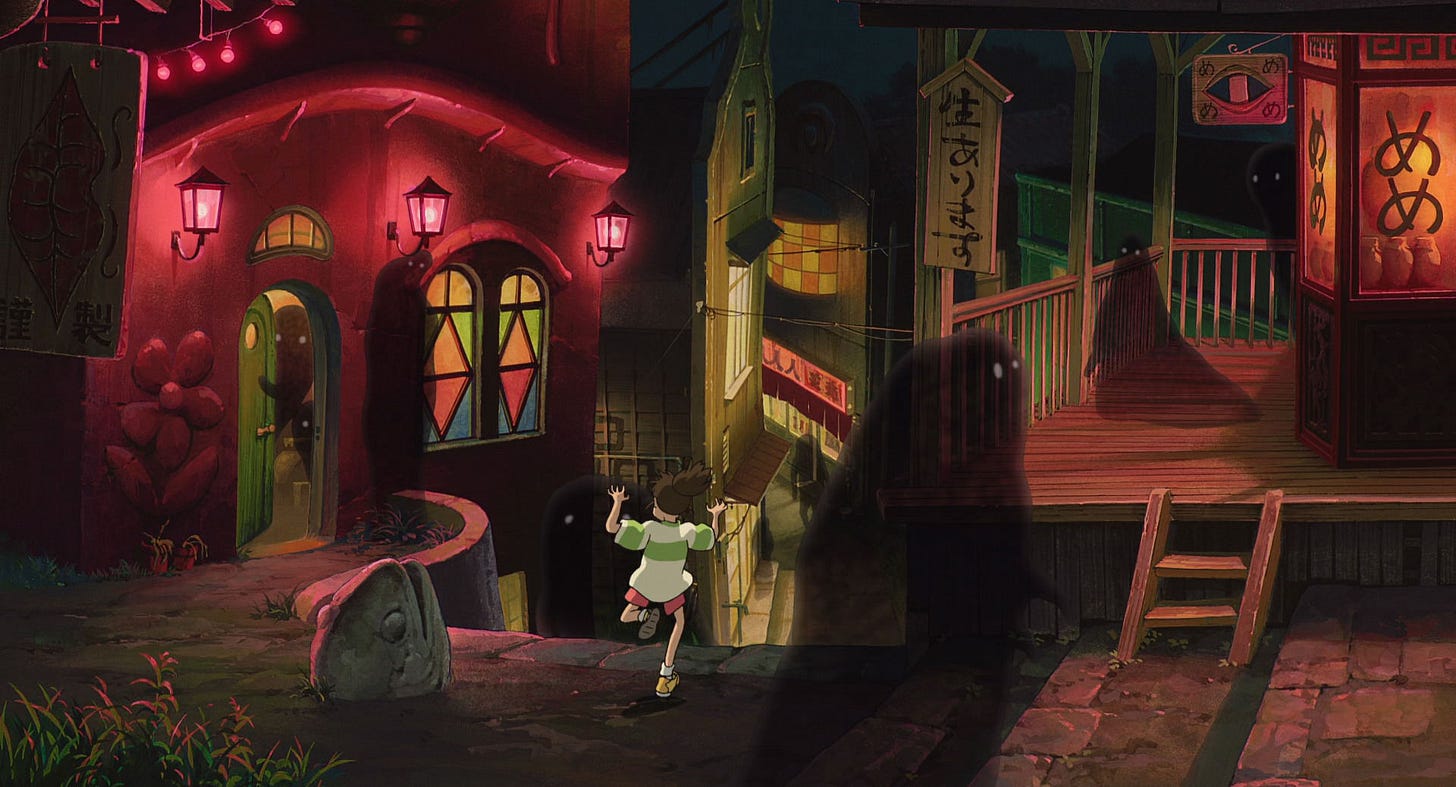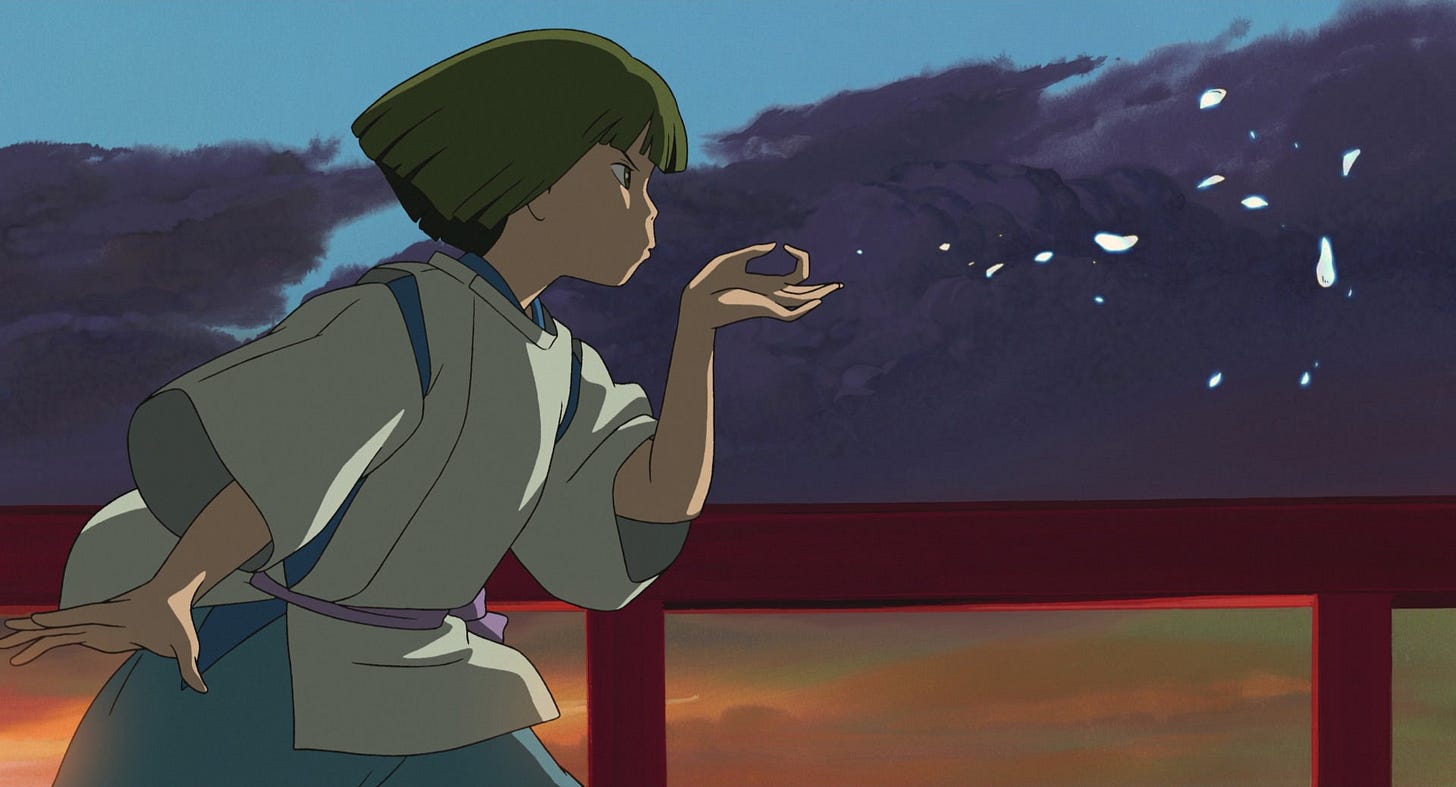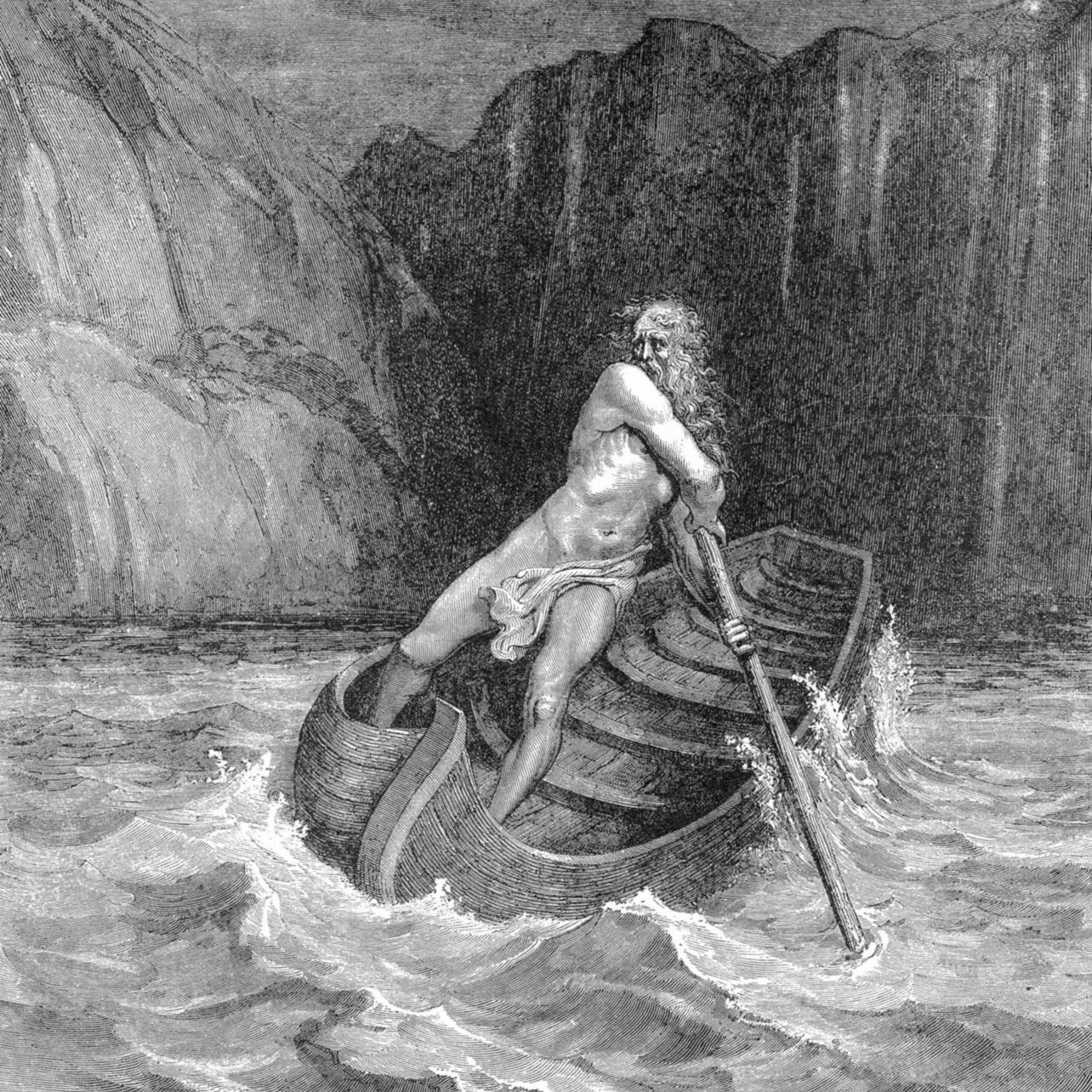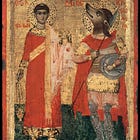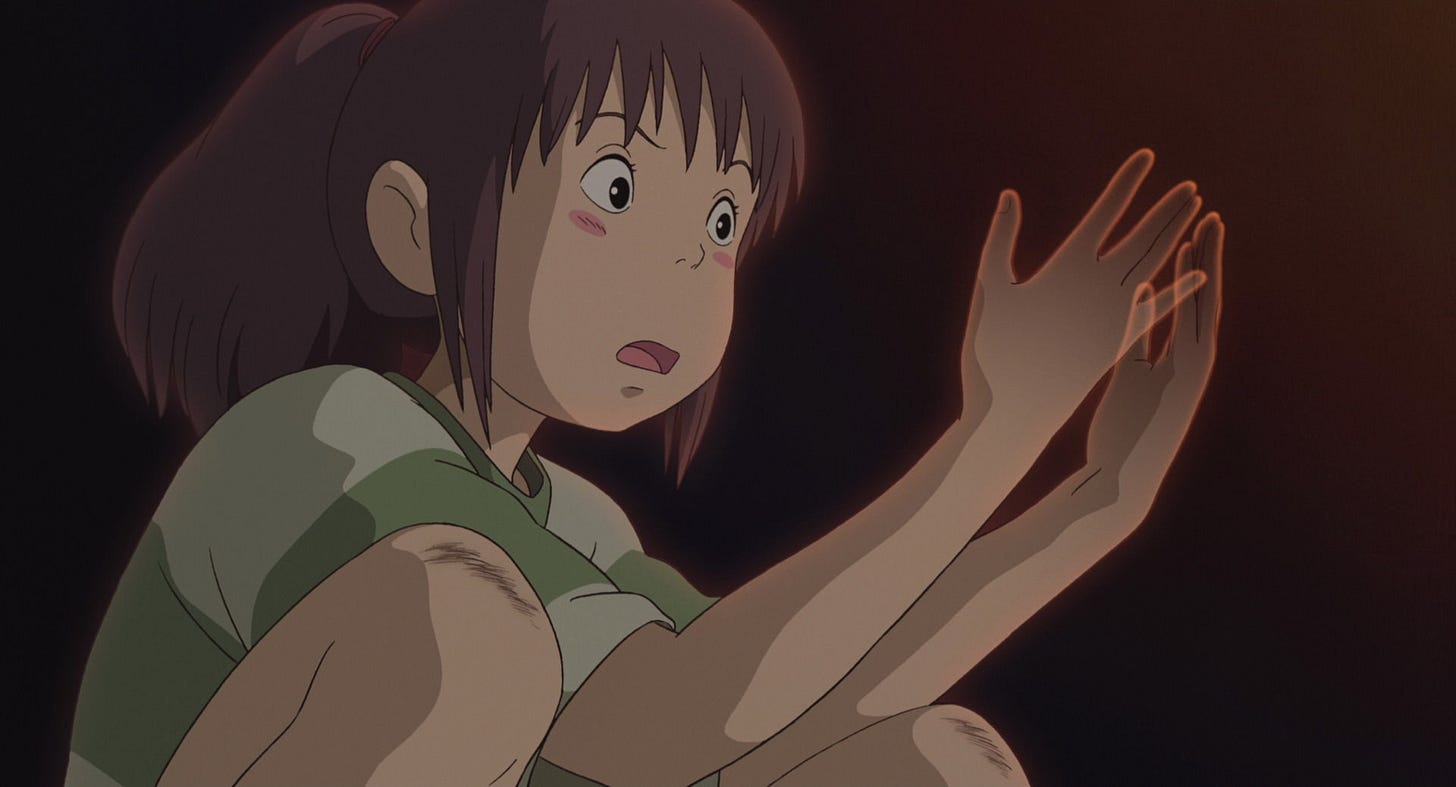Welcome to Falling Sand. We invite you to slow down, listen deeply, and rediscover the mystery of a world spoken into being.
Illumine our minds, our hearts, and our spirits, Lord.
In the name of the Father, Son, Holy Spirit.
Amen.
Let us begin.
The Shō of Spirited Away – Dwelling Within Otherworld
In our last post, we explored the Ki of Spirited Away—the opening act in the four-part Kishōtenketsu structure. We saw how Chihiro’s ordinary world slowly bent toward the strange, culminating in her crossing a sacred threshold.
Now, we proceed to the second movement: Shō—development. This is where the world of the story unfolds. Chihiro enters into the spirit realm and begins to understand its laws, its dangers, and its cost. It’s the part of the tale where names are lost, souls are tested, and the path of transformation begins.
In the context of Spirited Away, a question comes to my mind which is fitting for our postmodern age: What does it mean to remain human in a world that has forgotten what a person is?
The In-Between
Enter Shō.
Night has fallen and the world around Chihiro is quickly changing. Spirits now appear, seemingly from every nook and cranny. She tries to return the way she came, but the river (which has spewed forth from the mouth of a stone frog—a note to circle back on later) now blocks her way back to the train station. Her parents are no longer recognizable. They’re pigs, still feasting at the table of their own desire. Even the bathhouse, the only shelter in sight, refuses her entry. As we will later find out, her human scent betrays her.
Chihiro now stands in the threshold space—unable to move forward or backward. This is the chaos of the in-between, the space between categories where identity dissolves and nothing really makes sense.
The twilight hour, the edge of the forest outside of the castle walls, the mouth of a tunnel, the bridge—these are liminal zones where the boundary between the human world and the spirit world thins. In Japanese folklore, such spaces are dangerous and spiritually charged. But these zones can also be places of transformation if properly interacted with. In Shinto, crossing into the realm of the kami without proper ritual or purification invites spiritual disorder. Chihiro has done just that. She has entered the sacred unprepared and is now lost in the margins.
In Christian cosmology, these places shadow the condition of fallen man—exiled from Eden, cast into a chaotic world no longer familiar, disoriented and unnamed. This in-between space is the outer darkness, the realm of tempting and distraction (logismoi) where the creature loses its likeness to the Creator, forgetting what he truly is. It reminds me of the Chronicles of Narnia, where some of the beasts have become “dumb beasts” forgetting their ordering principles such as language.
And yet, like the belly of a whale, this place can also be the womb of repentance.
Then Jonah prayed to the Lord his God from the belly of the fish, saying, “I called out to the Lord, out of my distress, and he answered me; out of the belly of Sheol I cried, and you heard my voice.” (Jonah 2:1-2)
Like Israel in the wilderness or the prodigal son in the far country, this place is not the end. Rather, this is where the journey truly begins. Not a journey of conquest, but of humility. Like Spitited Away, these are stories of remembering who one truly is.
And it is precisely in this moment—when all seems lost for Chihiro in the place between worlds—that Haku appears.
Mediator of Worlds
It is important to note that Haku isn’t simply a character with answers. In Japanese folklore, this type of beings often appears when someone crosses into the realm of spirits. These are creatures of the threshold—creatures who often act as bridges. Part spirit, part human; part water, part air; both familiar and otherworldly… whatever they are, they are never completely human.
Haku is a river spirit (though at his first meeting with Chihiro he has forgotten it.) His physical body (water) ties him to the human world but as a spirit-being he is able to move within the economy of the bathhouse as well. He can operate within and without both domains, yet he completely belongs to neither.
Such figures are universal in the world of myth and symbol. To loosely quote Carl Jung, these are psychopomps. Soul guides. These are the beings who can walk between lines and mediate the boundary of living and the dead, chaos and order, spiritual and material, human and divine. It is for this very reason that they can help others cross safely through.
In the Western fairy story The Frog Prince by the Brothers Grimm, the frog is a liminal creature of this sort. In our created world, frogs are amphibious creatures. Border-dwelling animals perfectly at home in both land and water. They straddle the line between Yin and Yang. Chaos and order. In the fairy story, the prince exists in a cursed middle state. Yet this is the very creature capable of diving into the murky abyss of a well to retrieve the princess’ most prized possession, a golden ball.
Charon, the ferryman of the underworld within the Greek mythos, is perhaps the most archetypal psychopomp. He dwells on the river Styx which isn’t in the world of the living, nor truly among the dead. He exists in that strange place of passage, helping souls cross from one side to the other.
Nested within Christian cosmology is the strange story of St. Christopher—a dog-headed creature of the margins just human and beastly enough to cross people over tumultuous waters.
All of these stories echo something deeper… greater.
Christ, in his incarnation has become the ultimate mediator between worlds. Yet, he isn’t merely a guide. He is the very gate, path, and ark.
“I am the gate,” Christ says. “No one comes to the Father except through me” (John 10:9; 14:6).
Unlike the Nestorians of past and present would have us believe, he is fully God and fully man. In taking on flesh, He entered the visible world. In His death, He descended into Hades and harrowed it.
“In saying, ‘He ascended,’ what does it mean but that he had also descended into the lower regions of the earth? He who descended is the one who also ascended far above all the heavens, that he might fill all things.” (Ephesians 4:9–10)
Christ’s Incarnation was a uniting of realms: heaven and earth, spirit and matter, Creator and creation. Christ is the threshold. He stands where no other can stand: at the meeting of all opposites. In Him, the ultimate boundary between death and life is undone. This is why the Christian can confidently say:
“O Death, where is your sting? O Hades, where is your victory?” (1 Corinthians 15:55)
Haku is but a shadow of this greater reality. This is why he is able to act as a guide for Chihiro in the world of spirits.
Spiritual Food as Means of Ontological Transformation
In Part II of this series, we talked in great detail about how the parents’ eating of the spiritual food transformed them for the worse. The feasting of their passions brought upon ontological change… they were turned into pigs.
Now, something strange is happening. We are about to see spiritual food used as a means of ontological transformation in a different light. For Chihiro, the eating of spiritual food will become her sustenance, salvation, and identity-anchor.
The sun fades, the spirits come out, the waters rise… and Chihiro begins to (literally) fade. It seems only a matter of time before she disintegrates into nothingness. It is here where Haku intercedes for the second time, offering her food from the spirit world.
His command is brief and loaded with spiritual weight:
“Eat this. If you don’t eat food from this world, you’ll disappear.”
Immediately, her color begins to come back. She is no longer disintegrating from this world, but rather integrating. In a very real sense, she has take a part of the world into her—joined herself with it. This is a mystery… and rightly so.
This is not just nourishment. This is salvation through participation. The spirit world will not receive you unless you eat its food, speak its language, breathe its laws. This is not unlike the biblical stories of exile (think Daniel in Babylon, Joseph in Egypt) where the faithful must learn the customs of a foreign kingdom without forgetting their God.
There is also a heavy symbolic parallel to the proper receiving of the Eucharist. The Eucharist (body and blood of Christ) is both the medicine of immortality and the banquet of the Bridegroom. It is not merely food. It is a means to ontological union with God.
The food of the spirit realm acts not as mere sustenance, but as a kind of sacrament that outwardly manifests inward truths. Chihiro’s parents devour the food with a self-centered, gluttonous arrogance. They take without asking, eat without reverence, and treat the spiritual realm as if it were a market place where everything has a price tag.
Chihiro, by contrast, does not eat until she is invited. She does not seek out food to satiate her own appetite. Rather, Haku offers it to her freely. The food does not transform her into something else because she has not sought it out for her own desire for strength or pleasure. Rather, she receives it as a child, trusting Haku that it will save her. Chihiro, in a sense, begins her healing through this first spiritual meal. This is anamnesis, the “remembrance” that the Eucharist enacts. It is the undoing of spiritual amnesia. And it is how the likeness is restored. The same substance, then, becomes judgment to the proud and life to the humble.
St. Paul writes:
“Whoever, therefore, eats the bread or drinks the cup of the Lord in an unworthy manner will be guilty of profaning the body and blood of the Lord. Let a person examine himself… For any one who eats and drinks without discerning the body eats and drinks judgment upon himself. That is why many of you are weak and ill, and some have died.” (1 Corinthians 11:27–30)
There is a weighty warning here. Not because the mysteries are death-dealing, but because the soul must be rightly prepared to receive them.
This is similar to how the uncreated light of God functions: heaven for the saints, hell for the damned, but the same fire.
I suppose this is a good place to stop for now. And I realize a promise has been broken.
I initially thought this would be a five-part series, but here we are at the end of number three, and I’m only about sixteen minutes into the film. In next post, we’ll continue on with the movement of Shō, hopefully venturing into the strange bathhouse. But before we ascend the elevators to the very top where the dragon hoards her gold, we must first descend to the boiler room to meet Kamaji and his spirited soot.
Good night and God bless you, my joys.
